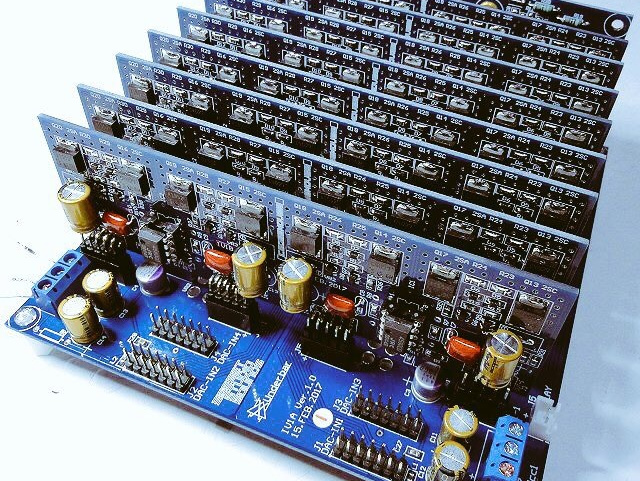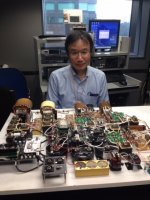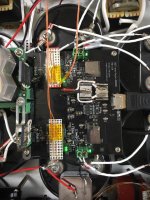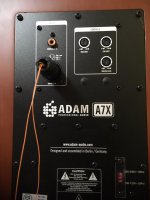So my inclination is not to use more than one chip unless you went dual stereo (or n-channel) - basically just stacking chips.
Russ, you may recall I tweaked Legato resistors to compensate for different driver efficiencies in a 3-way system running from 3 separate stereo 9018s. Would corrections between separate I/V stages be a viable approach for normalizing 9038 chip outputs in dual mono setups? Where are non-linearities a factor?
Russ, you may recall I tweaked Legato resistors to compensate for different driver efficiencies in a 3-way system running from 3 separate stereo 9018s. Would corrections between separate I/V stages be a viable approach for normalizing 9038 chip outputs in dual mono setups? Where are non-linearities a factor?
You situation is understandable - and that is a sensible approach.
You can definitely adjust to get equal output voltage - but when you start changing the resistance on the feedback loops to match the output impedance between channels (right and left for instance - not high, low, mid) you start to change the phase margin and other variables in the transimpedance amp... so you really can't factor that out. This is particularly troublesome when you have filter caps involved. The effects are not necessarily catastrophic - just not ideal. It would definitely start to mess with imaging and soundstage.
My first impression on ES9038PRO Dual Mono DAC
Just one week ago, I received the first prototype DAC board from my friend Chiaki. The board has two ES9038PRO chips. Its base is his Dual Mono DAC with ES9018S devices.
http://www.diyaudio.com/forums/digital-source/142562-microsd-memory-card-transport-project-64.html#post3628074
He made minimum design modifications required for replacing ES9018S with ES9038PRO.
Though I am making no side-by-side, apple-to-apple comparison, it is very obvious that the new ES9038PRO Dual Mono DAC gives us a superior sound quality. The degree of sound resolution is the highest one I experienced with DACs at my hand. Not so much commercial high-end DACs might exceed the resolution the ES9038PRO DAC has achieved. At the same time, bass is much improved. It gets more powerful and speedy.
I like the ES9038PRO best among DAC chips available in a current market! I'd like to express my sincere gratitude to all members of the development team in ESS Technologies.
Just one week ago, I received the first prototype DAC board from my friend Chiaki. The board has two ES9038PRO chips. Its base is his Dual Mono DAC with ES9018S devices.
http://www.diyaudio.com/forums/digital-source/142562-microsd-memory-card-transport-project-64.html#post3628074
He made minimum design modifications required for replacing ES9018S with ES9038PRO.
Though I am making no side-by-side, apple-to-apple comparison, it is very obvious that the new ES9038PRO Dual Mono DAC gives us a superior sound quality. The degree of sound resolution is the highest one I experienced with DACs at my hand. Not so much commercial high-end DACs might exceed the resolution the ES9038PRO DAC has achieved. At the same time, bass is much improved. It gets more powerful and speedy.
I like the ES9038PRO best among DAC chips available in a current market! I'd like to express my sincere gratitude to all members of the development team in ESS Technologies.
Also interesting to know what kind of I/V stage you have used, psu with your setup?
My I/V stage is a simple use of line-transformers of FINEMET core. Therefore, the increase of analog output current has brought me quite a good result without any modification.
Chiaki's DAC board requires five separate +5V power inputs for Digital Left Channel, Digital Right Channel, Analog Left Channel, Analog Right Channel, and Common Clock Section. For Analog Left and Right, one psu is assigned. Because of increase of current draws, I replaced the original power transformer with a new one. For each Digital Section psu, TPS7A4700-based, no modification has been made.
ES9038PRO has power such input pins,
Pin 1 VDD_L : Analog Power (+1.2V) for Left channels
Pin 20 DVDD : Digital Power (+1.2V) for core logic
My friend in Japan told me that the Analog Power (+1.2V) line and the Digital Power (+1.2V) line were directly connected to each other internally.
Does anyone confirm this?
Pin 1 VDD_L : Analog Power (+1.2V) for Left channels
Pin 20 DVDD : Digital Power (+1.2V) for core logic
My friend in Japan told me that the Analog Power (+1.2V) line and the Digital Power (+1.2V) line were directly connected to each other internally.
Does anyone confirm this?
Just one week ago, I received the first prototype DAC board from my friend Chiaki. The board has two ES9038PRO chips. Its base is his Dual Mono DAC with ES9018S devices.
Hi, Bunpei,
Does Mr Chiaki have a web shop to order these DAC boards ?
Does Mr Chiaki have a web shop to order these DAC boards ?
Hi, LinuksGuru!
Thank you very much for your reply. My friend, Chiaki released one first prototype board and three second prototype boards. All these prototype were exclusively distributed to users of his previous ES9018S Dual Mono DAC board for an initial evaluation purpose. No further release plan has been announced yet. The reasons why he has no plan so far is that he can't expect so much prospective users;
1. Some DIYers in Japan are releasing their variety of ES9038PRO DAC board kits.
2. Chiaki's ES9038PRO Dual Mono DAC second prototype board costed more than 1,000 USD/piece.
3. A great effort is required to get a full advantage in sound quality of his board. For example, Bunpei prepared totally 10 separate power supply lines for the DAC board, for his transport SDTrans384 and for DuCULoN OCXO.
(Please look at the picture attached to this post.)
If you are very eager to get an ES9018PRO Dual Mono DAC board, please post your comment here.
Attachments
Direct connection of analog output of ES9038PRO to studio monitor speaker
Some DIYers for ES9038PRO based DAC boards may have difficulties in designing of an I/V stage as ES9038PRO provides more analog current per channel than ES9018S does.
For example, a Japanese designer created such a I/V module for his "Monster" ES9038PRO Quad DAC board.
CrossOver >> pg16

In my case, an alternative simple approach was tried for analog outputs of Chiaki's ES9038PRO Dual Mono DAC.
As a left analog output, all eight channels of DAC chip for left are merged, and as a right analog output, all eight channels for right, respective for + and -. ( as shown in the first picture attached.)
These lines for analog+, analog- are directly connected to a balance input XLR connector of an active studio monitor speaker. Here, no GND connection is applied.( as shown in the first picture attached.)
The resultant SQ is satisfactory!
Some DIYers for ES9038PRO based DAC boards may have difficulties in designing of an I/V stage as ES9038PRO provides more analog current per channel than ES9018S does.
For example, a Japanese designer created such a I/V module for his "Monster" ES9038PRO Quad DAC board.
CrossOver >> pg16

In my case, an alternative simple approach was tried for analog outputs of Chiaki's ES9038PRO Dual Mono DAC.
As a left analog output, all eight channels of DAC chip for left are merged, and as a right analog output, all eight channels for right, respective for + and -. ( as shown in the first picture attached.)
These lines for analog+, analog- are directly connected to a balance input XLR connector of an active studio monitor speaker. Here, no GND connection is applied.( as shown in the first picture attached.)
The resultant SQ is satisfactory!
Attachments
These lines for analog+, analog- are directly connected to a balance input XLR connector of an active studio monitor speaker. Here, no GND connection is applied.( as shown in the first picture attached.)
The resultant SQ is satisfactory!
Thanks for the report, Bunpei. The input impedance of the A7X is listed at 30K ohms. Have you tried more demanding inputs, or perhaps headphones? Sound quality while driving more demanding gear?
Cheers!
Thanks for the report, Bunpei. The input impedance of the A7X is listed at 30K ohms. Have you tried more demanding inputs, or perhaps headphones? Sound quality while driving more demanding gear?
Hi, francolargo! I appreciated your reply!
Yes. When necessary, I usually monitor the raw analog output of ESS DAC chip connecting Etymotic Research ER-4S (original in-line resistors were removed and connected in a balance topology).
In this case, I can listen to a crude sound of delta-sigma modulation.
Bunpei
Hi Bunpei,
Interesting to read your short description of the ESS 9038's sound - thanks for posting it! Any chance you have been able to listen to the AK4497 in a quality layout/design? Or, if not, do you have any information about how is it perceived in Japan relative to the ES9038?
Cheers,
Jesper
Interesting to read your short description of the ESS 9038's sound - thanks for posting it! Any chance you have been able to listen to the AK4497 in a quality layout/design? Or, if not, do you have any information about how is it perceived in Japan relative to the ES9038?
Cheers,
Jesper
Any chance you have been able to listen to the AK4497 in a quality layout/design? Or, if not, do you have any information about how is it perceived in Japan relative to the ES9038?
Hi, Jesper!
As you may know, some DAC board DIY kit designers in Japan have already released their boards for both AK4497 and ES9038PRO, for example;
Mr. Yanagida (Yana-san)
ES9038DM DAC基板
AK4497DM DAC基板
Mr. Fujiwara (Okiraku, easy-audio)
http://www.easyaudiokit.com/bekkan/es9038pro/es9038pro3.html
http://www.easyaudiokit.com/bekkan/es9038pro/es9038pro4.html
However, I have never listened to any of them in an apple-to-apple comparison manner.
At least, I have just listened one for ak4497 by Mr. Yanagida at a room of my friend.
Therefore, your question is very tough for me.
When I listened to AK4497 DAC one of my friend assembled, anyhow, I had such an impression that SQ of AK4497 and ES9038PRO was converging.
On the other hand, it's true that there are many supporters for AK4497 here.
Bunpei
Hi Bunpei,
Thanks for your brief update on a couple of AK4497 & DAC9038 designs and your/the Japanese perception of both ... As it is I'm quite intrigued by the new ES9038 - not least due to its much more powerful output stage - however, I've been told that each channel's output basically is a paralleling of 4 ES9018 output stages ... And previously I was told from a probably reasonably reliable source that the ES9018 due to its sampling structure should generate some listening fatique over time, i.e. when listening for longer periods of time ... Not to imply that this would be the case with the 9038 but if Esstech have mainly paralleled the outputs there could be a chance/risk that this aspect would be similar ... Anyway, I'm considering both DACs as well as an R2R design so I am interested in somehow finding out ...
Thanks again for your feedback, Bunpei, and best wishes for your day in Japan ;-)
Jesper
Thanks for your brief update on a couple of AK4497 & DAC9038 designs and your/the Japanese perception of both ... As it is I'm quite intrigued by the new ES9038 - not least due to its much more powerful output stage - however, I've been told that each channel's output basically is a paralleling of 4 ES9018 output stages ... And previously I was told from a probably reasonably reliable source that the ES9018 due to its sampling structure should generate some listening fatique over time, i.e. when listening for longer periods of time ... Not to imply that this would be the case with the 9038 but if Esstech have mainly paralleled the outputs there could be a chance/risk that this aspect would be similar ... Anyway, I'm considering both DACs as well as an R2R design so I am interested in somehow finding out ...
Thanks again for your feedback, Bunpei, and best wishes for your day in Japan ;-)
Jesper
- Home
- Source & Line
- Digital Line Level
- ESS Sabre Reference DAC (8-channel)


